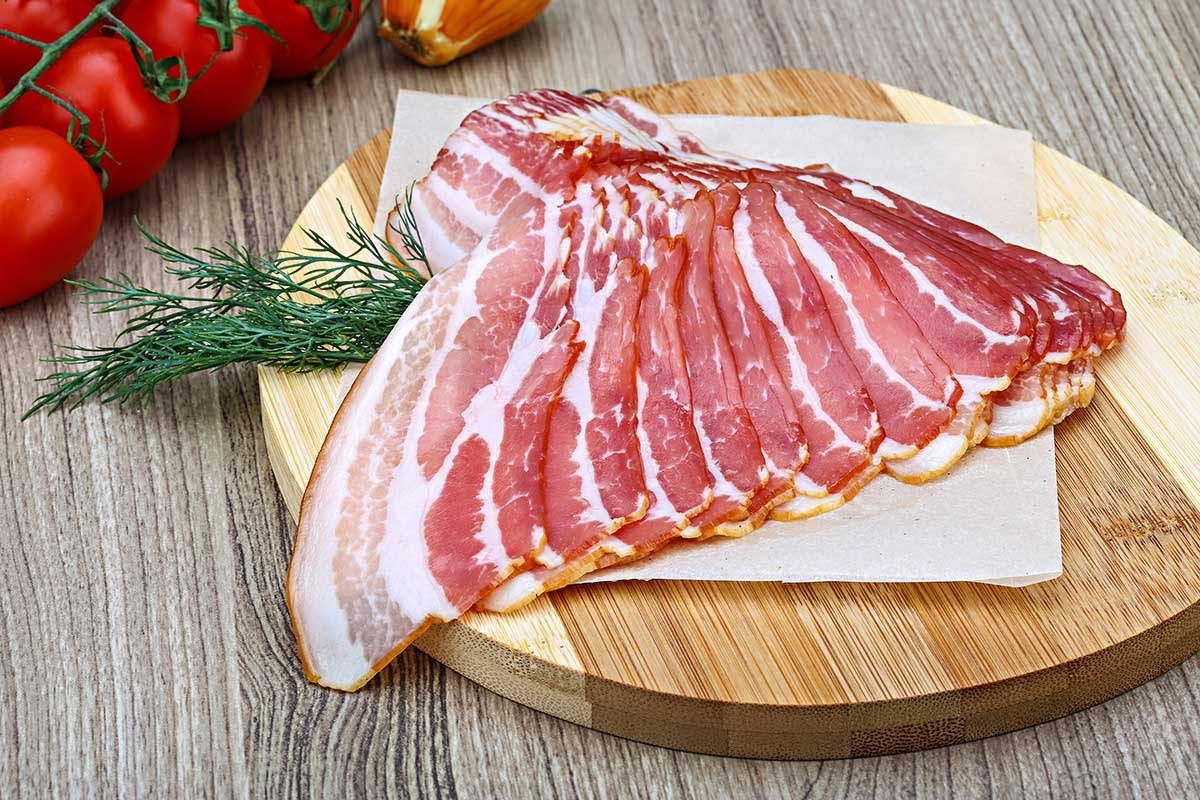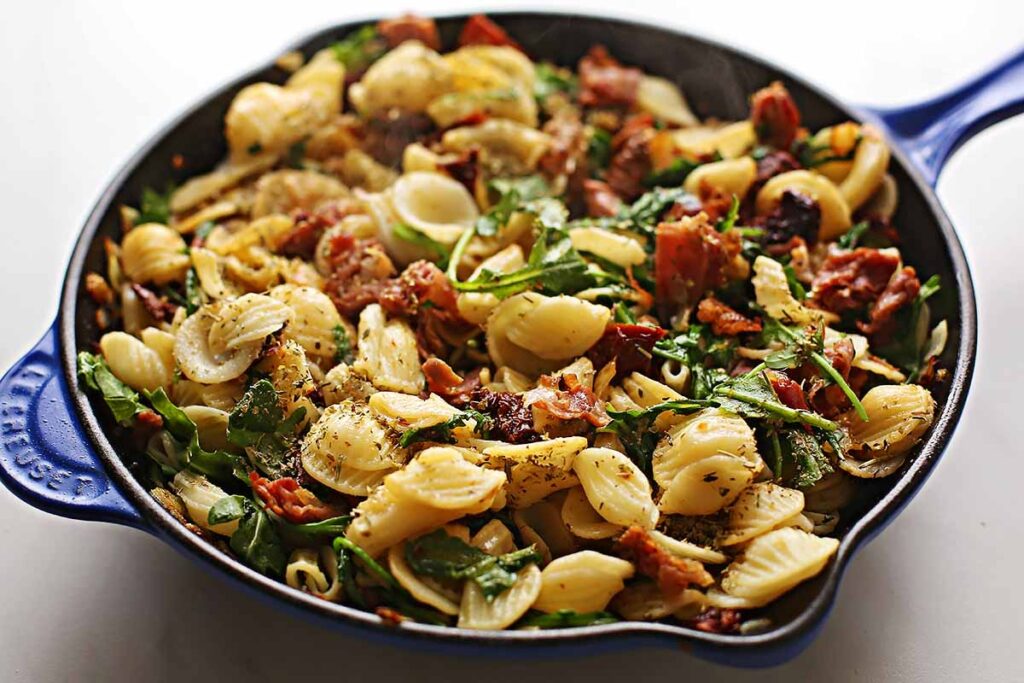What is Prosciutto? It is a culinary gem that people worldwide love. It boasts a divine and luscious taste, delicate texture, and irresistible aroma.
This ham, crafted from the pig’s leg, undergoes a meticulous curing process. The result? A velvety slice of meat that melts in your mouth. Read on and find out everything there is to know about this ham.

Prosciutto is an Italian dry-cured ham. The word “prosciutto” comes from the Latin term “perex suctum,” which translates to “dried out.”
Its origins date back to ancient times. At the time, Italian villagers used dry aging to preserve meat during harsh winters. Today, the art of creating this ham is popular in Italy and worldwide.
When you look at a slice of prosciutto, you’ll immediately notice its distinct hue. This ham can be anywhere from pink to brownish-red. You’ll not miss the streaks of fat that contribute to its texture and flavor.
The ingredient list is short; the classic recipe only calls for the hind leg of a pig and salt. However, the process is lengthy and meticulous.
Even the breed of pigs from where the leg will come from have specifications. After the meat undergoes curing, there is a thorough inspection before the ham sells in the market.
There are several types of prosciutto, with Prosciutto di Parma being the most famous. Some varieties cure for 400 days, while others call for up to 3 years of curing time.
This cured meat frequently finds its place on antipasto platters. After all, it pairs well with bread and fruit.
One of the classic ways to enjoy it is to wrap it around a slice of cantaloupe.
Initially, the meat is generously coated in salt and stays that way for several weeks.
This first salting phase plays a vital role. It draws out blood and moisture. This process effectively keeps away bacteria and enhances the flavors of the meat.
Then, a second salting process takes place. This stage cures the meat and uses lesser salt than the first salting.
After the second salting, any remaining salt is brushed off then the dry-aging follows. As mentioned, people use special dry-aging chambers for this ham. After all, the quality and flavor highly depend on this process.
The meat dry ages in a controlled environment where temperature and other elements are constant. How long the meat stays in this stage varies. It depends on the type and the particular region.
On average, this stage spans from 14 to 36 months. The amalgamation of salt, air, and time comes together throughout this process. They give this cured meat its beloved sweet and delicate flavor profile.
To make other varieties, people use spices other than salt. Each family uses their recipe to make their ham different from the classic ones.

Prosciutto is a delectable cured meat with lots of delightful flavors.
It boasts the perfect balance between sweetness and salty flavor.
Some varieties have an array of spices and herbs. These ingredients like nutmeg, cinnamon, juniper berries, and cloves. Spices like these impart the ham a unique and fragrant flavor profile.
The aging process also plays a vital role in the taste of prosciutto.
Young prosciutto has a soft and moist texture with a sweet taste. As the meat matures, it develops a more complex flavor.
Aging adds layers of delightful intricacy to prosciutto. As you place a slice on your tongue, the fat dissolves. It creates a luscious, creamy texture that envelops your palate.
There are two general kinds of prosciutto. They differ regarding their state, as one is cooked while the other is not.
The uncooked variety is called Prosciutto Crudo. It is the general term for raw but cured ham. For this reason, if you see Prosciutto and it does not say what kind it is, it is probably a Prosciutto Crudo variety.
The cooked version of this deli meat is called Prosciutto Cotto. Specifically, it is a steamed ham. As a result, most of its fat melts, leaving a delectable lean piece of meat. It is still flavorful and has less sodium than Crudo.
There are several kinds of prosciutto you might come across with. Do note that there are many variations. Everyone can have their version, but here are a few notable types you should know about.
Most popular kinds come with a DOP designation. This designation means that the entire process of making the ham is regulated.
Prosciutto di Parma DOP is a prestigious Italian cured ham. It uses meat from carefully selected breeds of pigs that hail from certain regions of Italy.
The entire salting and aging process must take place in the Parma province. This region has distinct conditions that make the ham unique.
This variety only uses sea salt and relies heavily on air and time to do the work. Every Prosciutto from Parma should age for at least 400 days by law.
Prosciutto di San Daniele DOP hails from the beautiful Friuli Venezia Giulia region. This location has a high altitude and a unique climate. As a result, this type develops a darker and sweeter flavor.
After the salting process, the ham undergoes a pressing stage. This process flattens the meat, setting it apart from all other cured meats.
Flattening the ham not only enhances the penetration of salt. It also gives the ham its recognizable guitar shape. This shape adds to its visual appeal and showcases its unique craftsmanship.
Modena is a province in Emilia-Romagna’s northern region. It boasts a rich gastronomic heritage, particularly in prosciutto making.
The area experiences warm, humid summers. However, its winters are colder. This climate provides ideal conditions for making Prosciutto di Modena DOP.
Prosciutto di Modena ages anywhere between 14-30 months.

The best way to enjoy it is to eat it on its own.
If you particularly have Prosciutto Crudo, make paper-thin slices first. This way, when you place it in your mouth, its fat melts effortlessly. You’ll enjoy the salty and sweet lean part of the ham.
You may also eat this ham with cheese and wine. Better yet, you must try it with bread, vegetables, or fruit.
Prosciutto comes from high-quality pork legs, specifically the hind legs. This part of the pig is mostly lean but has beautiful fat marbling. The fat marbling gives the ham a delightful taste.
No, you do not need to cook prosciutto to enjoy it. The salting and aging process effectively kills any bacteria. These processes make the cured ham safe for raw consumption. Prosciutto Cotto is a cooked ham, so there is no need to cook it further.
Prosciutto uses the hind leg of a pig, while bacon uses the belly. Furthermore, bacon needs cooking, while prosciutto does not.
Like bacon, pancetta uses meat from the pig’s belly, while prosciutto uses the leg. Pancetta is the American version of bacon, so it also needs cooking. Prosciutto is meant to be eaten raw.
Prosciutto is a culinary treasure many people love. After all, it has a heavenly taste, delicate texture, and amazing aroma. This cured meat undergoes a delicate curing process. As a result, you get a velvety slice of meat that melts in your mouth.
There are different kinds of prosciutto. Parma, Modena, and Prosciutto Toscano are among the most popular ones. Each kind has its characteristics. You can eat it alone or serve prosciutto with bread, cheese, or fruit. This Italian ham has an amazing harmony of sweetness and saltiness. It is a true culinary delight.





